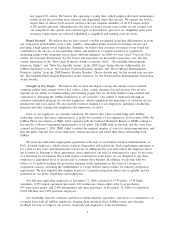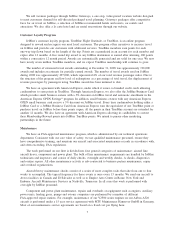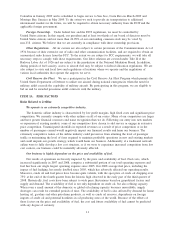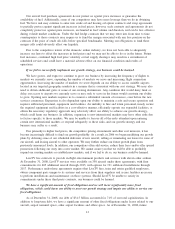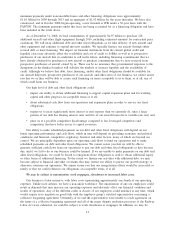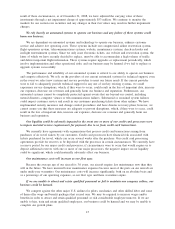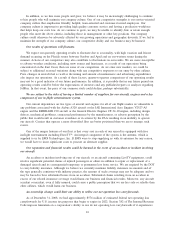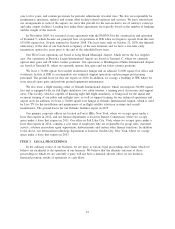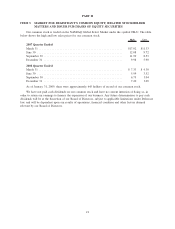JetBlue Airlines 2008 Annual Report Download - page 22
Download and view the complete annual report
Please find page 22 of the 2008 JetBlue Airlines annual report below. You can navigate through the pages in the report by either clicking on the pages listed below, or by using the keyword search tool below to find specific information within the annual report.minimum payments under noncancelable leases and other financing obligations were approximately
$1.10 billion for 2009 through 2013 and an aggregate of $1.92 billion for the years thereafter. We have also
constructed, and in October 2008 began operating, a new terminal at JFK under a 30-year lease with the
PANYNJ. The minimum payments under this lease are being accounted for as a financing obligation and have
been included in the totals above.
As of December 31, 2008, we had commitments of approximately $4.97 billion to purchase 128
additional aircraft and other flight equipment through 2016, including estimated amounts for contractual price
escalations. We will incur additional debt and other fixed obligations as we take delivery of new aircraft and
other equipment and continue to expand into new markets. We typically finance our aircraft through either
secured debt or lease financing. The impact on financial institutions from the current global credit and
liquidity crisis may adversely affect the availability and cost of credit to JetBlue as well as to prospective
purchasers of our aircraft that we undertake to sell in the future, including financing commitments that we
have already obtained for purchases of new aircraft or purchase commitments that we have received from
prospective purchasers of aircraft owned by us. There can be no assurance that governmental responses to the
disruptions in the financial markets will stabilize the markets or increase liquidity and the availability of
credit. Although we believe that debt, lease financing, and/or other fixed obligations should be available for
our aircraft deliveries, prospective purchasers of our aircraft, and other areas of our business, we cannot assure
you that we or they will be able to secure such financing on terms acceptable to us or them, or at all, any of
which could harm our business.
Our high level of debt and other fixed obligations could:
• impact our ability to obtain additional financing to support capital expansion plans and for working
capital and other purposes on acceptable terms or at all;
• divert substantial cash flow from our operations and expansion plans in order to service our fixed
obligations;
• require us to incur significantly more interest or rent expense than we currently do, since a large
portion of our debt has floating interest rates and five of our aircraft leases have variable-rate rent; and
• place us at a possible competitive disadvantage compared to less leveraged competitors and
competitors that have better access to capital resources.
Our ability to make scheduled payments on our debt and other fixed obligations will depend on our
future operating performance and cash flows, which in turn will depend on prevailing economic and political
conditions and financial, competitive, regulatory, business and other factors, many of which are beyond our
control. We are principally dependent upon our operating cash flows to fund our operations and to make
scheduled payments on debt and other fixed obligations. We cannot assure you that we will be able to
generate sufficient cash flows from our operations to pay our debt and other fixed obligations as they become
due, and if we fail to do so our business could be harmed. If we are unable to make payments on our debt and
other fixed obligations, we could be forced to renegotiate those obligations or seek to obtain additional equity
or other forms of additional financing. To the extent we finance our activities with additional debt, we may
become subject to financial and other covenants that may restrict our ability to pursue our growth strategy or
otherwise constrain our operations. We cannot assure you that our renegotiation efforts would be successful or
timely or that we could refinance our obligations on acceptable terms, if at all.
We may be subject to unionization, work stoppages, slowdowns or increased labor costs.
Our business is labor intensive, with labor costs representing approximately one-fourth of our operating
expenses. Unlike most airlines, we have a non-union workforce. The unionization of any our employees could
result in demands that may increase our operating expenses and adversely affect our financial condition and
results of operations. Any of the different crafts or classes of our employees could unionize at any time, which
would require us to negotiate in good faith with the employee group’s certified representative concerning a
collective bargaining agreement. Ultimately, if we and the representative were unable to reach agreement on
the terms of a collective bargaining agreement and all of the major dispute resolution processes of the Railway
Labor Act were exhausted, we could be subject to work slowdowns or stoppages. In addition, we may be
13


